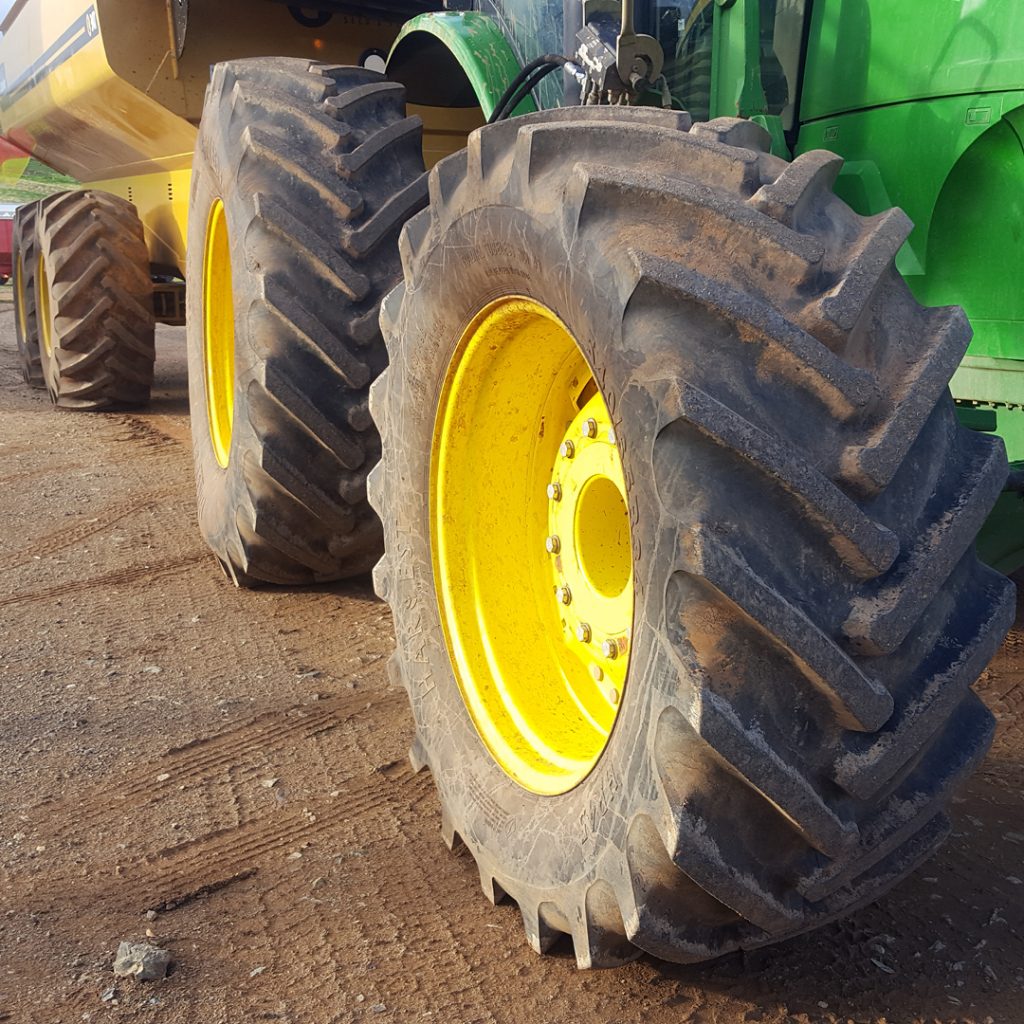Tractor Tyres: Radial vs Bias Ply Tyres
Construction
Everyone in the tyre industry say they know the difference between Radial Ply and Bias Ply tyres, but what is it really?
The Harvest radial ply tyres have single or multiple nylon plies running radially, bead to bead, with the tread being reinforced with an inextensible reinforcing polyester belt package.
The Harvest bias ply tyre has multiple nylon diagonal plies (30-40 degree angle), bead to bead, and diagonal breaker plies can be used to reinforce the tread. The two constructions make the pneumatic tyre look and operate differently in both field and road applications.
Differences In Service Operation
For all pneumatic tyres “AIR CARRIES THE LOAD”. This rule does not change for Radial or Bias Ply tyres. The air pressure inside the tyre is equal to the contact pressure on the ground in both cases with the exception to Harvest x-load tadial tyres that can create a lower pressure.
The Harvest radial ply tyre has a longer and narrower contact patch with the ground when compared to the Harvest bias ply tyre. The Harvest radial polyester belt holds the tread pattern and keeps it stable as the tyre rolls through the contact patch at various speeds. The tread pattern always compresses together as it goes through the contact patch and the radial polyester belt supports the tread pattern so that it compresses evenly. This allows for low soil compaction whilst maintaining traction.
A radial ply tyre is like a caterpillar track on any rubber or steel track vehicles. It sits the tread pattern on top of the surface. The circumference of the belt is the rolling circumference of the radial tractor tyre.
The bias ply tyre is not as rigid as the radial ply tyre under the tread pattern. The tread pattern moves and squirms as the bias ply tyre rolls through the contact patch. The bias plies also move over each other as the tyre distorts in the contact patch. This increases the tread squirm. The bias ply tyre conforms to the shape of the ground surface. It envelopes around small rocks and ruts rather than bridging over them as in a radial ply tyre. This additional squirm and movement are why the bias ply tyre tread pattern wears more quickly than the radial ply tyre. It is also the reason for its shorter and wider contact patch and means that it is prone to overheating.

Advantages and Disadvantages of Radial vs Bias Ply Tyre.
ADVANTAGES OF RADIAL
- Increased drawbar pull for the same tyre load.
- Tyre load and pressure can be reduced for the same draw bar pull as a bias ply tyre – thus reducing soil compaction.
- Cooler running in operation especially on sealed roadway and harder surfaces.
- Good high speed capability as tyre runs cooler lower rolling resistance as tread is held more rigid better tread wear.
- Easier to fit on a wheel as the sidewall is more flexible longer contact area more tread is in contact with the surface.
- Good flotation capacity.
- Good straight line stability.
- Has a higher speed rating than bias ply in.
DISADVANTAGES OF RADIAL
- More expensive and complex to manufacture soft and flexible sidewall is easier to damage and puncture.
- Special tread design required to remove mud and dirt from between tread lugs.
- Special design required to reduce bead slippage on wheel.
- Bead cracks more common in service.
- Single bead construction (no dual beads).
- Wheel weights preferred to liquid ballast inside tyre.
- More difficult to repair.
- Specialist knowledge required to set weights and inflation pressure to deliver optimum performance in varying conditions of use.
- Size matching must be precise to eliminate hop and bounce in front wheel assist tractors.
- Tubeless tyres more difficult to fit and repair in the field.
ADVANTAGES OF BIAS PLY
- High compliance to variation in surface and operating conditions at speeds less than 30kph.
- Strong damage resistant sidewalls.
- Tough and flexible casing resists damage.
- Tyre conforms well to rough and soft terrain during cyclic loading operations.
- Can work well at very low speeds under low pressure – good flotation.
- 45 degree tread lug self cleans due to inherent squirm through contact patch.
- Good lateral stability (hill side work).
- Good in rough and harsh terrain, mining and log skidder work.
- Good puncture resistance, easy to repair.
- Simple to set up pressures and loads.
- No power delivery problems, tyre tread slip improves compliance in set-up.
- Lower purchase price.
DISADVANTAGES OF BIAS PLY
- Less draw bar pull than a radial ply tyre.
- Difficult to fit to some shallow well wheels.
- Reduced tread wear for - harder surfaces, high traction and high speed operation.
- Cannot run at low pressures under normal or high speed operation as tyre heats up due to its extra flexing.
- Poor flexibility in casing and tread squirm in contact patch reduces draw bar pull and traction.
- Profile of tyre increases soil compaction and reduces traction for equivalent load and draw bar pull in a tractive operation.
- Casing impact damage possible under high inflation pressure and light loads.
- Operates at a lower speed than a radial tyre of the same equivalent size.
